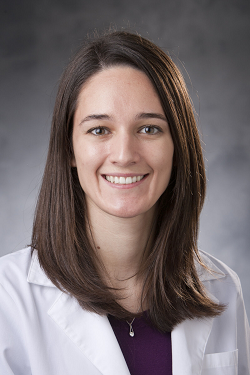
Myopia -- or nearsightedness -- used to mean thick glasses, contact lenses, and progressively worse vision. But that may be changing. Duke Health pediatric optometrists now use specialized soft, multifocal contact lenses and prescription eyedrops to slow -- or even stop -- the advancement of myopia. That’s an important development because as myopia progresses, it can increase your child’s risk of developing serious eye conditions such as cataracts, glaucoma, and retinal detachment when they are older.
Does My Child Have Myopia?
For people with myopia, distant objects appear blurry, while near objects look clear. If your child holds books, tablets, or homework close to their face, sits too close to the TV, or squints or closes one eye to read, they may have myopia. And they would not be alone.
A Nearsighted Nation
Over 40 percent of the U.S. population has myopia, and the problem is getting worse, explained Yos Priestley, OD, a pediatric optometrist at the Duke Eye Center in Durham and Holly Springs. “We’re seeing an increasing number of myopia cases in younger children.” Children with a parent who is nearsighted have a higher risk for developing myopia. Other risk factors, such as too much screen time and less time in the sunlight may also be to blame.
COVID Pandemic May Be a Culprit in Increasing Number of Myopia Cases
The COVID-19 pandemic has amplified the problem. “With more children indoors and on screens, we’ve seen an uptick in the progression of myopia,” said Dr. Priestley. “Others didn’t realize they were nearsighted because they were behind a computer all day.”
Duke Offers Innovative Myopia Treatments
Children who are nearsighted are traditionally prescribed glasses or contact lenses that, in most cases, increase in strength every year. Now, doctors are using low-dose atropine drops – commonly used to dilate the eyes – to stop myopia from worsening. Studies show the drops, typically given at bedtime, are slowing the rate of myopia by about half. Research has also found that children who start wearing multifocal contact lenses as early as age seven experience a slowing of myopia progression as well.
Getting a diagnosis of myopia and starting treatment as soon as possible is one way to stop the condition before vision worsens. Dr. Priestley and her colleagues at Duke’s pediatric myopia clinic at the Duke Eye Center offer longer appointment times and advanced testing to ensure their young patients get the most appropriate, tailored treatments.
So far, families are pleased with the results. “Every child has different needs and responds differently to treatment, but we do everything we can to slow myopia progression as much as possible,” said Dr. Priestley. “Given the increased rate of myopia, it’s beneficial to offer these new treatments to our patients.”
Article originally appeared in Duke Health Blog